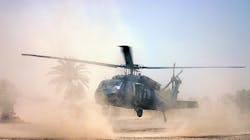Sierra Nevada to flight test synthetic vision to help helicopter pilots land in zero visibility
FORT EUSTIS, Va., 12 June 2013. U.S. Army helicopter avionics experts say they plan to ask Sierra Nevada Corp. in Sparks, Nev., to integrated and test a prototype synthetic-vision system on a Sikorsky UH-60 helicopter that is designed to help helicopter pilots land safely in zero-visibility conditions.
Officials of the Aviation Applied Technology Directorate of the Army Research, Development, and Engineering Command at Fort Eustis, Va., have announced their intention to award contract worth between $2 million and $8 million to Sierra Nevada to integrate and test the company's Helicopter Autonomous Landing System (HALS) aboard an Army UH-60A/L helicopter.
The Sierra Nevada HALS avionics uses a 3D image-rendering 94 GHz pulsed radar, global positioning system (GPS), inertial sensors, and cockpit displays to help helicopter pilots view geographic features outside the aircraft during brownouts and whiteouts from dust, snow, or other visual impairments.
Landing a helicopter in choking dust or blinding snow can be particularly difficult because pilots can become disoriented easily near the ground as they lose view of the horizon and other visual cues.
The HALS system uses radar data translated to color graphic representations on cockpit displays to help helicopter pilots control the aircraft's roll, pitch, and yaw based on radar-generated graphic representations of the ground and nearby geographic features in zero-visibility conditions.
Sierra Nevada Corp. has been developing a 94 GHz imaging radar system for synthetic-vision helicopter landing aids since 2005. Army officials say Sierra Nevada is uniquely qualified to integrate and test the HALS prototype on an Army helicopter, and so plan to award this contract sole-source.
Sierra Nevada experts will develop HALS software and sensors in support of the Army Aviation and Missile Research Development and Engineering Center's Degraded Visual Environment (DVE) mitigation effort, Army officials say.
Sierra Nevada will integrate government-furnished radome, two cockpit displays, and radar system electrical harness interface aboard the test UH-60 helicopter. The company also will perform software updates, imagery system enhancements, and engineering support for ground and flight testing.
The HALS avionics enables helicopter pilots to take off, land, and fly in all degraded visual conditions, provides visual situational awareness to enable pilots to see and avoid wires, cables, and terrain, and well as follow landmarks in poor visibility.
The system also includes Brownout Symbology Software (BOSS), precise guidance to landing in zero visibility, and safe transition from visual to instrument flying conditions.
For more information contact Sierra Nevada Corp. online at www.sncorp.com, or the Army Aviation Applied Technology Directorate at www.aatd.eustis.army.mil.
